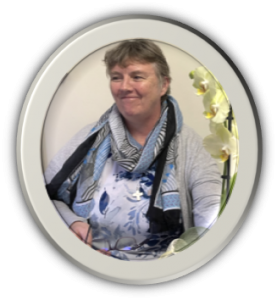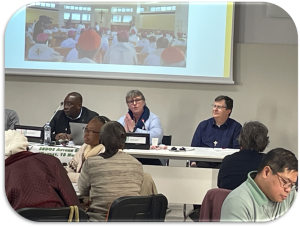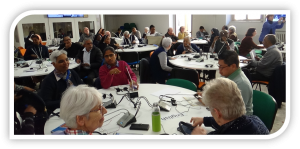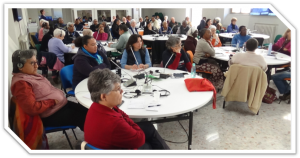Good morning everyone.
It is a pleasure to be with you all this morning for our SEDOS Autumn Seminar – for which we have chosen the theme ‘Mission and Synodality.
My focus is simply to share with you the experience of the Synod itself and as you have heard in the introductions, Fr Tesfaye will speak more to the actual content emerging from the Synod while Br Mark Hilton will speak to the challenges that we face in missionary religious life.
 Ongoing Process
Ongoing Process
It is impossible to speak of the experience of the Synod itself, without mentioning the lead-up to it. This Synod Session 2023 is part of a process that began in October 2021 – and if I remember correctly both myself and Tesfaye were present at that opening which took place in the Synod Hall. From October 2021 until around April 2023, much work was done right across the globe in the universal Church to listen to what people are saying about the life of the Church. The process began locally at Diocesan level and then moved to National and Continental Levels. So, we came to Synod 2023, the first of two Synod Sessions, having participated in and having listened to many of the faithful. In our particular case as Religious, we also had our own joint process of UISG-USG inviting our membership to reflect on the questions after which the fruits of the reflection were submitted to the Synod Office.
Levels of Participation
It was interesting to listen to the experiences from around the world gathered in Rome.
Often during the Synod, at least at the tables where I was participating, we heard echoes about poor participation, and I repeatedly heard it quoted about the 1% who participated. But that small percentage of participation was not really reflective of most of the churches across the world. It may have been true in some. It was very heartening to chat with people (Bishops and lay people alike) about the experience in their different countries, many times with wonderful enthusiastic participation which is already bearing fruit in their churches.
Remote Preparations
The Synod Secretariat made great efforts to ensure everyone was prepared for the event by organizing online gatherings by continent, and also organizing a meeting with the 10 USG-UISG delegates.
The preparation beforehand was very important answering our questions, explaining a little of how the organization would be, helping us prepare spiritually and concretely for the event.
We also selected the themes we wished to work on beforehand and these choices were respected in forming the table groups…
For each of the themes of the Synod: Communion, Participation, and Mission, there were five sub-themes and each person worked only on one sub-theme. Knowing the choice beforehand allowed us to have more time to discern and reflect and prepare our 4-minute input which kicked off the table sharing.
When did the Synod begin?
Someone recounted at the beginning of the Synod that Pope Francis was putting people to the test in the lead up to the Synod by asking them when the SYNOD began: and he was very happy if they answered correctly! It was not simply the work done between October 4th and 29th that counted as part of the Synod, but it began with the Ecumenical Prayer Service on September 30th, continued with the Retreat in Sacrofano and then settled into a rhythm for each of five modules that took place between Oct 4th and 29th.
Other important moments took place during the month – like the pilgrimage to the Catacombs and the prayer for Migrants as well as the Rosary for peace.
How to describe the Experience?
Depending on the different perspectives and experiences, different metaphors are used to describe the experience of XVI ORDINARY GENERAL ASSEMBLY OF THE SYNOD OF BISHOPS. I have heard people refer to it as a ‘Bootcamp’, using the military comparison. Others have referred to it as a laboratory – using the scientific comparison. I prefer to stay with our religious imagery and think of it as a formation programme – where we are being constantly moulded and formed into the Christian disciples we are called to be, as followers of Jesus. Whatever the metaphor, the time together in the Synod was a time of learning how to be Church together. It was an ongoing formation programme, where we were being pruned and shaped, to have ‘the mind and  heart of Jesus’. Our interactions with each other, particularly around the tables, challenged us to listen to each other and to the Spirit guiding us all. It was a transformative journey, calling us to grow in humility and in our understanding of what it is to be Church together, with the example of Jesus as the compassionate, welcoming servant leader guiding us on the journey.
heart of Jesus’. Our interactions with each other, particularly around the tables, challenged us to listen to each other and to the Spirit guiding us all. It was a transformative journey, calling us to grow in humility and in our understanding of what it is to be Church together, with the example of Jesus as the compassionate, welcoming servant leader guiding us on the journey.
I would like to approach my discussion of the experience along four parameters:
-
- A deep Spiritual Journey in a Sacred Space
- A Place of Respectful Encounters where new connections and friendships grow
- An exciting but exhausting experience
- A new space for women
-
1. A deep Spiritual Journey in a Sacred Space
The prayer moments were streamed live so I am sure many of you were able to follow them online. The time in Sacrofano was a very profound introduction to all that was needed from us if we were to engage with each other and be guided by the Holy Spirit during the Synod. From the get go we were invited to imagine what it is like to listen to very different perspectives and to know that the person with that different opinion is as close to Jesus as I am. Being together in that space helped to begin the process of building bridges and breaking down walls… the time shared over the meals and breaks was as important as the reflections and the time spent in adoration and meditation…. We were building the discerning community. It wasn’t easy! Imagine arriving alone into a dining room with over 400 people and trying to find a friendly table in a language you could communicate in. One of my table group remarked that the dining experience was a living hell for introverts! But that all changed the morning Timothy Radcliffe spoke about friendship… from then on people tried to be extra welcoming and offer a smile to all those passing searching for a table!
I mentioned earlier that the opening of the Synod process in October 2021 took place in the traditional Synod Hall. I am sure you have seen pictures and heard the stories of how that Hall is: a large lecture theatre and the seating arrangements were very traditional. I remember as we entered for the Opening Session in 2021, we were told to sit anywhere except in the first seven rows. As we entered, someone remarked to me, ‘I hope they are not reserving those for the Cardinals as that is not a good start for synodality!’ Sure, enough the first seven were reserved for the more ‘important’ people.
Fast forward to this experience. Again, I am sure you have seen the pictures – the wide expansive space of the Paul VI Hall – with 40 or so round tables seating 12 at each table. And around each table in no particular order were lay people, religious, diocesan priests, bishops, Archbishops and Cardinals. As we began in Sacrofano, we were asked how we liked to be addressed and most people asked to be addressed with their first name. So, it was very informal but respectful.
There were great efforts to create a prayerful and discerning atmosphere. The listening was profound and of equal importance were the prayerful moments of silence. At the table sharing, after everyone presented their four minutes, we had a time of silent reflection to get in touch with what was moving within us in response to what was shared. This was repeated after every round of sharing which made it relatively simple to note the divergences and convergences, questions and proposals from the group.
There were profound moments of silence in the General Assemblies also, after every four three-minute reports; Again, this helped us go deep within and not simply react or respond from the head to what we were hearing.
We all learned the importance of deep listening and moments of silence for discerning together. True listening is transformative and I think it is safe to say everyone in that hall was transformed. I know I have been changed by the process of being there. We could sense it in each other. And some people freely shared their experience of beginning to actually understand the perspective of other people that was very different to theirs. It truly was a spiritual journey in a sacred space.
The other prayer experiences were also deeply significant: the pilgrimage to the Catacombs, where we were given the text of the pact of the Catacombs signed by some 40 Bishops towards the end of Vatican II, challenged us on the synodal journey. It could have been written for us today. For those of you who have never read it, it is certainly worth pondering. The prayer for migrants and refugees before the Angels Unawares monument was stark and moving, reminding us of the focus of a synodal missionary Church. And of course, we had several prayers for peace.
Personally, in spite of the intense month and the fatigue that came with it, I never grew tired of arriving into that Hall each morning to begin the day. It was a friendly space, it was a holy space, the Spirit was with us, in and among us.
2. A Place of Respectful Encounters where new connections and friendships grow
You can imagine that with the universal Church in that room, all the different vocations, voices from different Christian Churches, there were many different opinions on the diverse subjects we were addressing. There were also representatives of countries that are at war with each other – we had delegates from Russia and Ukraine for example. But because of the methodology used, the profound listening in which we were engaged enabled us to hold all those differences in tension without becoming polarized. We were also invited to allow the differences to be, simply to note them as divergences. What was amazing was that the points of convergence by far outweighed the divergences. There were some very powerful and moving interventions and discussions. I remember the day we were working on the question of women, on the urgency of including women in roles of responsibility, leadership and governance, allowing the giftedness of women to influence and guide the Church, the level of convergence on this issue was so strong and palpable in the room. One Bishop sitting beside me remarked that this is a powerful moment – what a discussion on the question of women in the Church. It was very moving.
The manner in which the Synod was organized, invited us into friendships… of course you have already heard a lot about the table sharing and really this did facilitate a growing in getting to know each other…
We were introduced to the conversation in the spirit methodology when we went to Sacrafano for the retreat which allowed us to begin to connect and know each other. The group we shared with during the retreat, for the most part was our ‘base group’. That is my terminology! We began the first module with more or less the same group we had for retreat: then for the next three modules we were sent out to other tables to meet other participants, before finally coming back together to our base group for the final module to work on the synthesis document together. Of course, most of us were within one language group which limited the connections a little. But we did our best to mix and mingle across the linguistic barriers.
It was an amazing experience to be around those tables with people from all parts of the world. Quite often there were representatives of all continents at the one table. My base table had a strong Asia focus, from Hong Kong, Philippines, Korea and India. We also had Oceania, North America and Europe with an African as our facilitator and an Armenian Ecumenical Delegate.
Another particular special encounter in that Synod Hall was the possibility of greeting Pope Francis. He attended most of the General Congregations, those for the opening of each module and those for listening to feedback from the table discussions. Any day he was attending, he came to the hall very early – up to 45 minutes before the session was beginning. And he was available to greet and take photos with participants. I began to take it for granted that every few days I could go and greet Pope Francis, shake his hand, share a joke!
He has a great sense of humour. The first day that we had feedback from the tables, there was some confusion at our table. Each table elected the person who would give the feedback so I was chosen by our group. But sitting right beside me was the much more well-known Bishop Barron from the US. The president delegate called Bishop Barron to give the report. I simply said that the report from Table 23 was not given by Bishop Barron, but by the other Barron in the room, Sr. Mary Barron. Everyone found this very amusing – probably because as I spoke, the title on the screen in front of everyone was Bishop Robert Barron, but with my image. As someone commented to me later, it was like looking at a future vision of the Church! Pope Francis was highly amused. For a few days, anytime I was near Pope Francis he was teasing me about being Bishop Barron.
The experience was also one of getting to know our Pope in a different way, such a simple, humble, model of leadership who is so present to everyone. Every member has their story of encounter, some very touching.
3. An exciting and exhausting experience
Because of the nature of the Synod, because of the methodology being used, because of the physical set-up, there was a real sense that this was an historic moment for our Church and beyond. It was exciting to be part of it.
It was exciting to be at the table, sometimes as the only woman, voicing a perspective that was different and feeling that I was being heard. We shared our perspectives, we shared what resonated within us as we listened to our different table participants and together we formulated a two-page summary document, capturing our convergences, divergences, questions and proposals. This was the basis for the three-minute report from each table.
The process for personal interventions was interesting: Once we ended the table discussions, there was then the feedback to the Assembly. And after the table reports, there was some time for free interventions, where anyone could take the floor and speak to the issue at hand.

We were warned from the beginning that in the free interventions, priority would be given to those who had never spoken before, to give an opportunity to as many members as possible to participate throughout the month. With 400 and more participants, it was unlikely that participants would get many opportunities to intervene personally. There was a sense of the need to be strategic and to decide on what topic I really feel I need to say something to add to the discussion. This was a very fair manner of selecting who intervened. It was different to previous Synods however, and so was not fully appreciated by all.
Personally, I was amazed at how easy I found it to voice my different opinion, even when I was the only woman at the table. One of my Sisters sent me a text message at one point saying, do not be afraid to speak your truth. I could honestly say I really had no fear, even when others doubted what I was saying or could not hear it. That lack of fear was the Spirit.
There were some great moments – pearls of wisdom shared by different members.
As a congregational leader, I was very touched by the sharing of one Cardinal, speaking about listening and the exercise of authority, he said: it is neither healthy nor holy to submit to the will of one who does not listen…. A great line which will continue to challenge me in leadership…
I was also very touched by the sharing of some of the ecumenical delegates, referring to their participation as a type of spiritual homecoming.
It was also an exhausting month… the timetable was full; days were long; and that level of intense listening is tiring. I was lucky – I was doing it in a language I am comfortable in. For many, though following in English (or whichever of the five languages of the Synod they were using) it was their second or third language and so was even more exhausting.

We were very aware of what was going on in the world also – not only from the news but because we had the whole world in the room. That also added a solemnity to our proceedings on many days. When there was an intervention from a part of the world in particular crisis, an appeal for prayer and support, there was inevitably a resounding spontaneous applause in support.
4. A new space for women
Finally, I am sure you will permit me to speak of this experience as a special and new experience for women.
It is not the first time that women attended the Synod: women have participated at least during the previous two synods and perhaps more.
But this is the first time there has been a woman as Secretary in the Synod Secretariat:
There have been women as President Delegates and so facilitating the sessions in the Synod: we had two of these: Sr. Maria de Los Delores Palencia from Mexico and Ms. Momoko Nishimura from Japan.
the first time that 54 women voted in the Synod.
There were over 90 women present in different capacities: facilitating, lending their theological expertise, assisting in the secretariat etc.
This was truly a new space that allowed women to fulfill their baptismal call to fully participate in being Church together.
In summary, this was an experience where the importance of the process by far outweighed the importance of the outcomes. The Synthesis document with the many proposals therein, has its importance, but the key learning from this Synod is to be found in the transformative experience lived by all participants. For many of us there was a relearning of how to listen to the voice of the Spirit of God as we listen deeply to each other with the diversity of contexts, cultures and perspectives, and try to discern what is the communal desire emerging from the Spirit moving in each other. The shared journey together has helped deepen our understanding of what it means to be a synodal Church, rooted in the vision of the Church as People of God, calling forth the giftedness of all the baptized as we discern together where the Spirit of God desires to lead God’s Church to fulfill the Missio Dei in our time. An unforgettable experience from which we can only continue to move forward.

